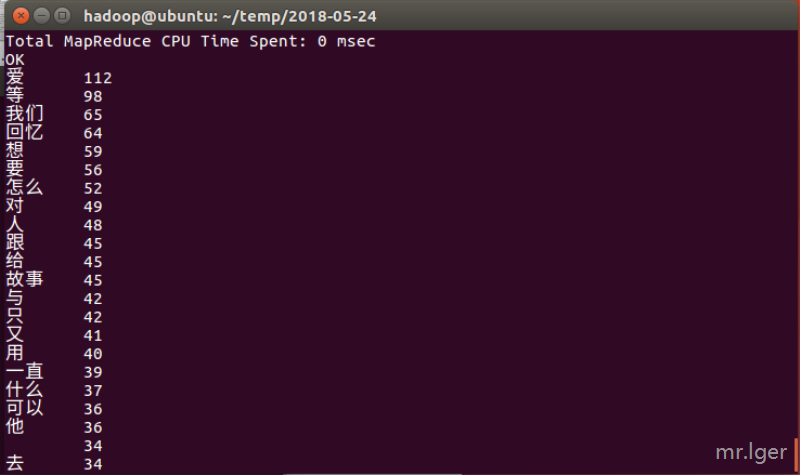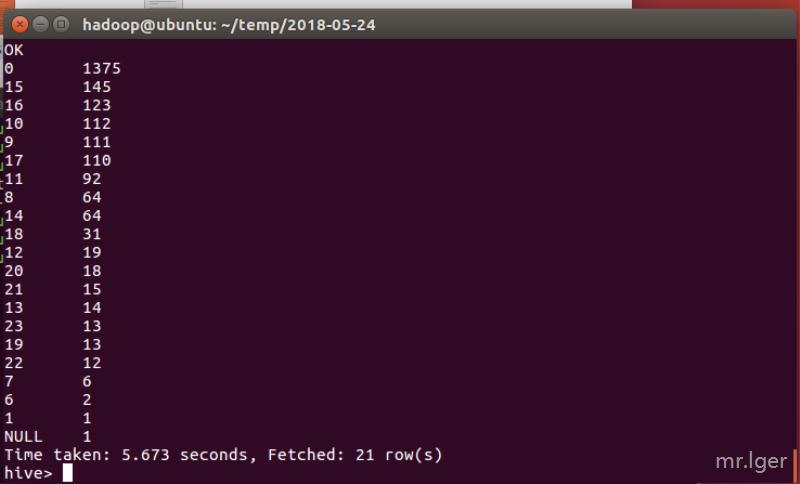Hadoop综合大作业 要求:
-
用Hive对爬虫大作业产生的文本文件(或者英文词频统计下载的英文长篇小说)词频统计。
-
用Hive对爬虫大作业产生的csv文件进行数据分析
1. 用Hive对爬虫大作业产生的文本文件
这里的具体操作步骤如下:
- 将网页上的歌词段落爬取下来
- 通过jieba分词后将结果用txt文件保存,
- 将txt文件放入Hadoop分布式文件系统
- 使用hive将文件作为表数据导入
- 使用hive查询统计歌词中单词的出现次数
首先,Python爬虫程序代码如下:
import jieba
import requests
from bs4 import BeautifulSoup
lyrics = ''
headers = {
'User-Agent': 'User-Agent:*/*'
}
resp = requests.get('http://www.juzimi.com/writer/%E6%96%B9%E6%96%87%E5%B1%B1', headers=headers)
resp.encoding = 'UTF-8'
print(resp.status_code)
soup = BeautifulSoup(resp.text, 'html.parser')
page_url = 'http://www.juzimi.com/writer/%E6%96%B9%E6%96%87%E5%B1%B1?page={}'
page_last = soup.select('.pager-last')
if len(page_last) > 0:
page_last = page_last[0].text
for i in range(0, int(page_last)):
print(i)
resp = requests.get(page_url.format(i), headers=headers)
resp.encoding = 'UTF-8'
soup = BeautifulSoup(resp.text, 'html.parser')
for a in soup.select('.xlistju'):
lyrics += a.text + ' '
# 保留爬取的句子
with open('lyrics.txt', 'a+', encoding='UTF-8') as lyricFile:
lyricFile.write(lyrics)
# 加载标点符号并去除歌词中的标点
with open('punctuation.txt', 'r', encoding='UTF-8') as punctuationFile:
for punctuation in punctuationFile.readlines():
lyrics = lyrics.replace(punctuation[0], ' ')
# 加载无意义词汇
with open('meaningless.txt', 'r', encoding='UTF-8') as meaninglessFile:
mLessSet = set(meaninglessFile.read().split('
'))
mLessSet.add(' ')
# 加载保留字
with open('reservedWord.txt', 'r', encoding='UTF-8') as reservedWordFile:
reservedWordSet = set(reservedWordFile.read().split('
'))
for reservedWord in reservedWordSet:
jieba.add_word(reservedWord)
keywordList = list(jieba.cut(lyrics))
keywordSet = set(keywordList) - mLessSet # 将无意义词从词语集合中删除
keywordDict = {}
# 统计出词频字典
for word in keywordSet:
keywordDict[word] = keywordList.count(word)
# 对词频进行排序
keywordListSorted = list(keywordDict.items())
keywordListSorted.sort(key=lambda e: e[1], reverse=True)
# 将所有词频写出到txt
for topWordTup in keywordListSorted:
print(topWordTup)
with open('word.txt', 'a+', encoding='UTF-8') as wordFile:
for i in range(0, topWordTup[1]):
wordFile.write(topWordTup[0]+'
')
现在将word.txt放入HDFS中并用hive查询统计,命令如下:
hdfs dfs -mkdir temp
hdfs dfs -put news.csv temp
hive
hive>
create database db_temp;
use db_temp;
create table tb_word(word string);
load data inpath '/user/hadoop/temp/word.txt' into table tb_word;
select word, count(1) as num from tb_word group by word order by num desc limit 50;
以上的运行结果截图如下:

2. 用Hive对爬虫大作业产生的csv文件进行数据分析
我这里选择了爬取校园新闻并生产csv文件来分析,首先编写爬虫,主要代码如下:
import requests
from bs4 import BeautifulSoup
from datetime import datetime
import re
import pandas
news_list = []
def crawlOnePageSchoolNews(page_url):
res0 = requests.get(page_url)
res0.encoding = 'UTF-8'
soup0 = BeautifulSoup(res0.text, 'html.parser')
news = soup0.select('.news-list > li')
for n in news:
# print(n)
print('**' * 5 + '列表页信息' + '**' * 10)
print('新闻链接:' + n.a.attrs['href'])
print('新闻标题:' + n.select('.news-list-title')[0].text)
print('新闻描述:' + n.a.select('.news-list-description')[0].text)
print('新闻时间:' + n.a.select('.news-list-info > span')[0].text)
print('新闻来源:' + n.a.select('.news-list-info > span')[1].text)
news_list.append(getNewDetail(n.a.attrs['href']))
return news_list
def getNewDetail(href):
print('**' * 5 + '详情页信息' + '**' * 10)
print(href)
res1 = requests.get(href)
res1.encoding = 'UTF-8'
soup1 = BeautifulSoup(res1.text, 'html.parser')
news = {}
if soup1.select('#content'):
news_content = soup1.select('#content')[0].text
news['content'] = news_content.replace('
', ' ').replace('
', ' ').replace(',', '·')
print(news_content) # 文章内容
else:
news['content'] = ''
if soup1.select('.show-info'): # 防止之前网页没有show_info
news_info = soup1.select('.show-info')[0].text
else:
return news
info_list = ['来源', '发布时间', '点击', '作者', '审核', '摄影'] # 需要解析的字段
news_info_set = set(news_info.split('xa0')) - {' ', ''} # 网页中的 获取后会解析成xa0,所以可以使用xa0作为分隔符
# 循环打印文章信息
for n_i in news_info_set:
for info_flag in info_list:
if n_i.find(info_flag) != -1: # 因为时间的冒号采用了英文符所以要进行判断
if info_flag == '发布时间':
# 将发布时间字符串转为datetime格式,方便日后存储到数据库
release_time = datetime.strptime(n_i[n_i.index(':') + 1:], '%Y-%m-%d %H:%M:%S ')
news[info_flag] = release_time
print(info_flag + ':', release_time)
elif info_flag == '点击': # 点击次数是通过文章id访问php后使用js写入,所以这里单独处理
news[info_flag] = getClickCount(href)
else:
news[info_flag] = n_i[n_i.index(':') + 1:].replace(',', '·')
print(info_flag + ':' + n_i[n_i.index(':') + 1:])
print('————' * 40)
return news
def getClickCount(news_url):
click_num_url = 'http://oa.gzcc.cn/api.php?op=count&id={}&modelid=80'
click_num_url = click_num_url.format(re.search('_(.*)/(.*).html', news_url).group(2))
res2 = requests.get(click_num_url)
res2.encoding = 'UTF-8'
click_num = re.search("$('#hits').html('(d*)')", res2.text).group(1)
print('点击:' + click_num)
return click_num
print(crawlOnePageSchoolNews('http://news.gzcc.cn/html/xiaoyuanxinwen/'))
pageURL = 'http://news.gzcc.cn/html/xiaoyuanxinwen/{}.html'
res = requests.get('http://news.gzcc.cn/html/xiaoyuanxinwen/')
res.encoding = 'UTF-8'
soup = BeautifulSoup(res.text, 'html.parser')
newsSum = int(re.search('(d*)条', soup.select('a.a1')[0].text).group(1))
if newsSum % 10:
pageSum = int(newsSum / 10) + 1
else:
pageSum = int(newsSum / 10)
for i in range(2, pageSum + 1):
crawlOnePageSchoolNews(pageURL.format(i))
# with open('news.txt', 'w') as file:
# file.write()
dit = pandas.DataFrame(news_list)
dit.to_csv('news.csv')
print(dit)
因为csv是用逗号分隔,而文章内容有逗号和换行符容易造成影响,所以在爬取数据时做了相应处理,将换行逗号等使用其他代替。爬取后将文件放入HDFS系统,并将第一行的数据删除,这里使用insert语句覆盖原先导入的表即可,然后通过hive查询做出相应操作分析文章作者在什么时候发表的量比较多。
hdfs dfs -put news.csv temp/
hive
hive>
create table tb_news(id string, content string, author string, publish timestamp, verify string, photo string, source string, click int)row format delimited fields terminated by ',';
load data inpath '/user/hadoop/temp/news.csv' overwrite into table tb_news;
insert overwrite table tb_news select * from tb_news where content != 'content';
select time_publish, count(1) as num from (select hour(publish) as time_publish from tb_news) tb_time group by time_publish order by num desc;

根据以上截图的结果可以看出,小编在发布时间大部分都是在0时,我只能说,熬夜不好